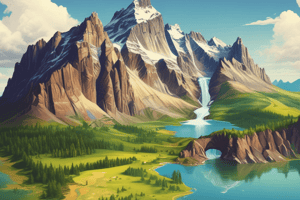Podcast
Questions and Answers
What was the original landmass from which the continents formed?
What was the original landmass from which the continents formed?
- Rodinia
- Gondwana
- Pangaea (correct)
- Laurasia
Which mountain range was NOT formed in western North America?
Which mountain range was NOT formed in western North America?
- Rockies
- Sierra Nevada
- Cascades
- Appalachians (correct)
What did low sea levels during the Great Ice Age expose?
What did low sea levels during the Great Ice Age expose?
- A desert region in North America
- An ocean route to Asia
- A land bridge connecting Eurasia and North America (correct)
- A volcanic island in the Atlantic
Which civilization is known for urban centers and far-flung commerce in Mesoamerica?
Which civilization is known for urban centers and far-flung commerce in Mesoamerica?
What agricultural technique does 'three-sister farming' refer to?
What agricultural technique does 'three-sister farming' refer to?
Who formed the Iroquois Confederacy?
Who formed the Iroquois Confederacy?
What major agricultural advancement was common in complex Native American civilizations?
What major agricultural advancement was common in complex Native American civilizations?
What distinguishes the Aztec civilization from other Native American groups mentioned?
What distinguishes the Aztec civilization from other Native American groups mentioned?
What motivated European powers to seek contact with the wider world during the centuries following the Crusades?
What motivated European powers to seek contact with the wider world during the centuries following the Crusades?
Which explorer is credited with rounding Africa's southernmost tip in 1488?
Which explorer is credited with rounding Africa's southernmost tip in 1488?
What significant event occurred on October 12, 1492?
What significant event occurred on October 12, 1492?
What was the result of the Columbian Exchange following Columbus's discovery?
What was the result of the Columbian Exchange following Columbus's discovery?
What impact did the introduction of horses have on Native American societies?
What impact did the introduction of horses have on Native American societies?
What was the encomienda system used for in the Spanish colonies?
What was the encomienda system used for in the Spanish colonies?
Which of the following factors significantly contributed to the defeat of the Aztecs by Hernan Cortés?
Which of the following factors significantly contributed to the defeat of the Aztecs by Hernan Cortés?
What was a key result of the Treaty of Tordesillas signed in 1494?
What was a key result of the Treaty of Tordesillas signed in 1494?
What term did Columbus use to describe the native peoples he encountered in the Americas?
What term did Columbus use to describe the native peoples he encountered in the Americas?
Which of the following captured Hernan Cortés's experiences on the tragedy known as noche triste?
Which of the following captured Hernan Cortés's experiences on the tragedy known as noche triste?
Flashcards are hidden until you start studying
Study Notes
Formation of Continents
- Pangaea was the original landmass from which continents evolved over millions of years.
- Major continents formed include Eurasia, Africa, Australia, Antarctica, and the Americas.
- Shifting earth crust created significant mountain ranges, including the Rockies, Sierra Nevada, Cascades, and Coast Ranges.
Geological Transformations
- The Canadian Shield, composed of ancient rocks, became integral to North American geography.
- The landscape underwent drastic changes after the retreat of glaciers, shaping valleys and rivers.
Impact of the Great Ice Age
- The Ice Age's low sea levels revealed a land bridge linking Eurasia to North America, facilitating human migration.
- This migration introduced the ancestors of Native Americans to the continent.
Civilizations of the Americas
- Major civilizations included the Incas in Peru, Mayans in Central America, and Aztecs in Mexico; notable for:
- Elaborate cities and extensive commerce.
- Advanced agricultural techniques, particularly corn cultivation.
- Sophisticated mathematical skills.
- Religious practices including human sacrifices among the Aztecs.
Social Structures and Practices
- Agriculture was foundational, leading to complex societies with irrigation systems and multi-storied dwellings.
- The Mound Builders thrived in the Ohio River valley, and Mississippian civilization existed at Cahokia.
- The Iroquois Confederacy developed significant political and organizational structures.
Early Exploration and Influences
- Norse explorers reached North America, specifically Vinland near present-day Newfoundland.
- The absence of strong nation-states in North America limited sustained explorations.
- Christian crusaders sparked European interest in Eastern luxuries and trade routes.
- Marco Polo’s accounts fueled curiosity for cheaper access to Asian treasures.
The Age of Exploration
- Technological advancements like the caravel enhanced maritime exploration, initiating colonization efforts.
- Bartholomeu Dias successfully rounded Africa’s southern tip in 1488.
- Spain gained political unity through the marriage of Ferdinand and Isabella, which paved the way for exploration.
Columbus and Discovery
- Christopher Columbus’s 1492 expedition, under Spanish sponsorship, landed in the Bahamas, mistaking the inhabitants for Indians.
- This discovery triggered monumental changes across four continents and initiated the Columbian Exchange, exchanging goods, crops, and diseases.
Consequences of Contact
- Introduction of Old World crops and animals transformed Native American societies; horses particularly impacted indigenous lifestyles.
- The "sugar revolution" arose, linked to African slavery in the New World’s plantations.
- Diseases from Europeans decimated Native populations.
Treaty of Tordesillas
- Signed in 1494, this treaty divided the New World between Spain and Portugal.
- The West Indies served as crucial bases for further Spanish expeditions.
Encomienda System
- A policy allowing colonists to "commend" Native Americans for Christianization, labeled as immoral by Bartolomé de Las Casas.
The Conquest of the Aztecs
- Hernan Cortés’s expedition in 1519 faced initial Aztec hospitality from Moctezuma; however, conflict ensued leading to the fall of Tenochtitlan in 1521.
- The siege combined military conquest with the catastrophic impact of European diseases on the Aztec population.
Studying That Suits You
Use AI to generate personalized quizzes and flashcards to suit your learning preferences.




